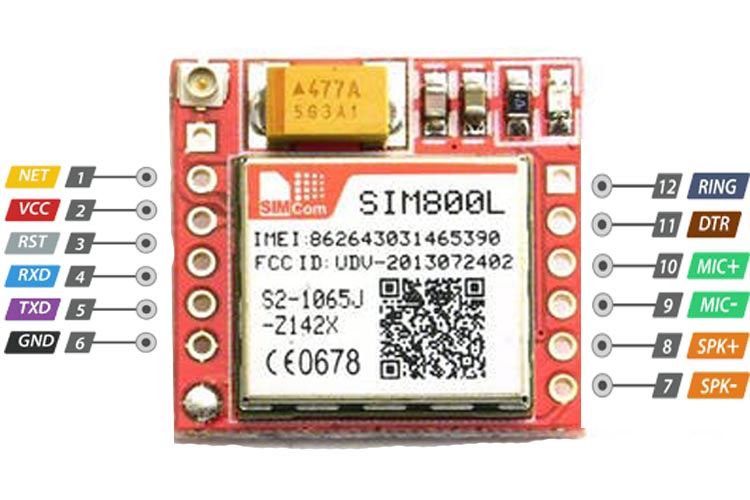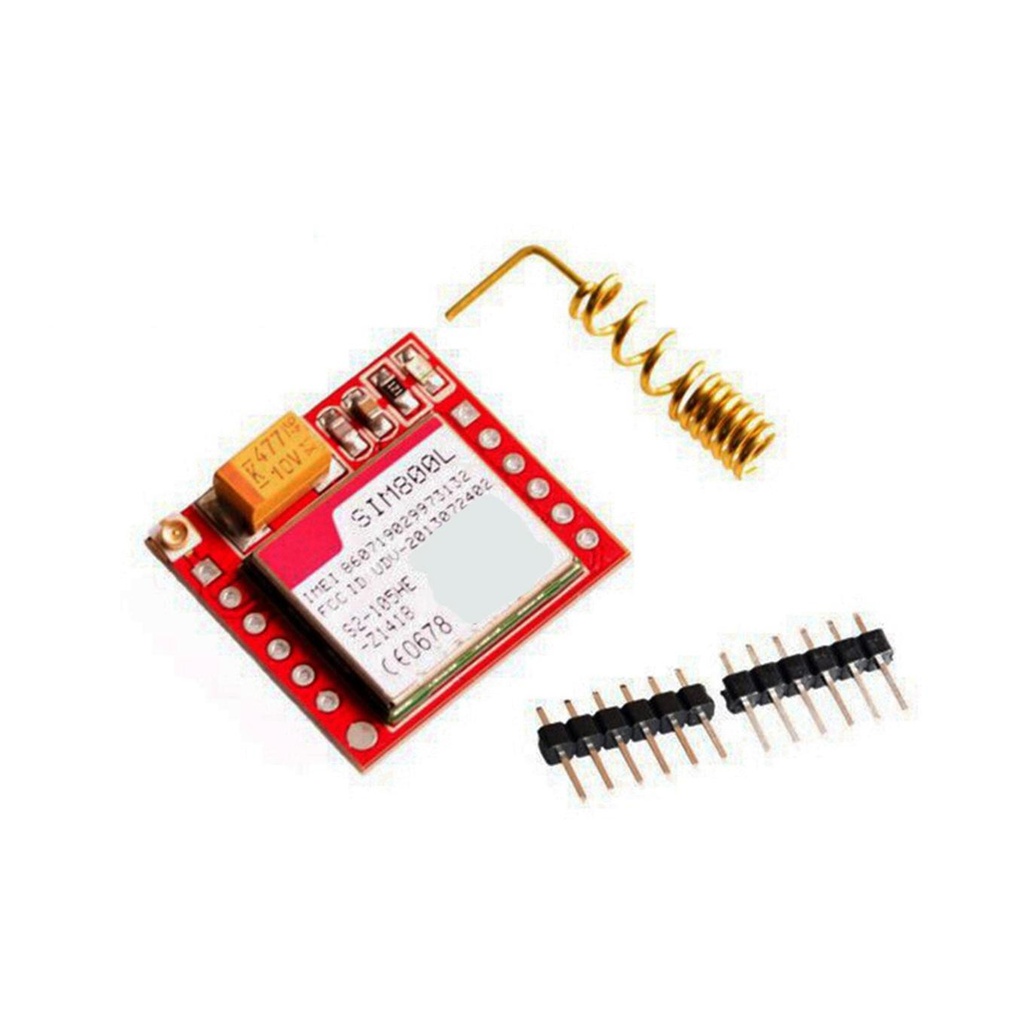Features:
- Supports Quad-band: GSM850, EGSM900, DCS1800, PCS1900
- Connect to any global GSM network with a 2G SIM
- Make/receive voice calls using external 8Ω speaker & electret microphone
- Send and receive SMS messages
- Send and receive GPRS data (TCP/IP, HTTP, etc.)
- Scan and receive FM radio broadcasts
- Transmit Power:
- Class 4 (2W) for GSM850
- Class 1 (1W) for DCS1800
- Serial-based AT Command Set
- FL connectors for external GSM antenna
- Accepts Micro SIM card
LED Status Indicators:
- Blink every 1s: Module running but no network connection
- Blink every 2s: Active GPRS connection
- Blink every 3s: Registered on network; voice and SMS ready
The Antenna:
A helical GSM antenna is included and should be soldered to the NET pin on the PCB. It saves space but may have lower reception indoors.
SIM800L GSM/GPRS Pinout:

- NET: Solder the included helical antenna here
- VCC: Supply 3.4V–4.4V (Do NOT connect to 5V or 3.3V directly)
- RST: Pull LOW for 100ms to reset
- RxD: Receive data (connect to TX of microcontroller)
- TxD: Transmit data (connect to RX of microcontroller)
- GND: Ground
- RING: Pulses LOW (120ms) on incoming call or SMS
- DTR: Sleep control (HIGH = sleep, LOW = active)
- MIC ±: Differential microphone input
- SPK ±: Differential speaker output
Example Arduino Code:

// Include SoftwareSerial for communication
#include <SoftwareSerial.h>
// Create software serial object for SIM800L communication
SoftwareSerial mySerial(3, 2); // SIM800L Tx to D3, Rx to D2
void setup() {
Serial.begin(9600); // Communication with PC
mySerial.begin(9600); // Communication with SIM800L
Serial.println("Initializing...");
delay(1000);
mySerial.println("AT"); // Test AT command
updateSerial();
mySerial.println("AT+CSQ"); // Check signal quality
updateSerial();
mySerial.println("AT+CCID"); // Check SIM card info
updateSerial();
mySerial.println("AT+CREG?"); // Check network registration
updateSerial();
}
void loop() {
updateSerial();
}
void updateSerial() {
delay(500);
while (Serial.available()) {
mySerial.write(Serial.read());
}
while (mySerial.available()) {
Serial.write(mySerial.read());
}
}
Features:
- Supports Quad-band: GSM850, EGSM900, DCS1800, PCS1900
- Connect to any global GSM network with a 2G SIM
- Make/receive voice calls using external 8Ω speaker & electret microphone
- Send and receive SMS messages
- Send and receive GPRS data (TCP/IP, HTTP, etc.)
- Scan and receive FM radio broadcasts
- Transmit Power:
- Class 4 (2W) for GSM850
- Class 1 (1W) for DCS1800
- Serial-based AT Command Set
- FL connectors for external GSM antenna
- Accepts Micro SIM card
LED Status Indicators:
- Blink every 1s: Module running but no network connection
- Blink every 2s: Active GPRS connection
- Blink every 3s: Registered on network; voice and SMS ready
The Antenna:
A helical GSM antenna is included and should be soldered to the NET pin on the PCB. It saves space but may have lower reception indoors.
SIM800L GSM/GPRS Pinout:

- NET: Solder the included helical antenna here
- VCC: Supply 3.4V–4.4V (Do NOT connect to 5V or 3.3V directly)
- RST: Pull LOW for 100ms to reset
- RxD: Receive data (connect to TX of microcontroller)
- TxD: Transmit data (connect to RX of microcontroller)
- GND: Ground
- RING: Pulses LOW (120ms) on incoming call or SMS
- DTR: Sleep control (HIGH = sleep, LOW = active)
- MIC ±: Differential microphone input
- SPK ±: Differential speaker output
Example Arduino Code:

// Include SoftwareSerial for communication
#include <SoftwareSerial.h>
// Create software serial object for SIM800L communication
SoftwareSerial mySerial(3, 2); // SIM800L Tx to D3, Rx to D2
void setup() {
Serial.begin(9600); // Communication with PC
mySerial.begin(9600); // Communication with SIM800L
Serial.println("Initializing...");
delay(1000);
mySerial.println("AT"); // Test AT command
updateSerial();
mySerial.println("AT+CSQ"); // Check signal quality
updateSerial();
mySerial.println("AT+CCID"); // Check SIM card info
updateSerial();
mySerial.println("AT+CREG?"); // Check network registration
updateSerial();
}
void loop() {
updateSerial();
}
void updateSerial() {
delay(500);
while (Serial.available()) {
mySerial.write(Serial.read());
}
while (mySerial.available()) {
Serial.write(mySerial.read());
}
}


